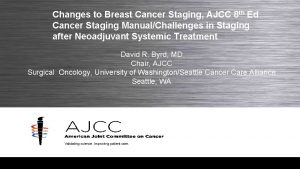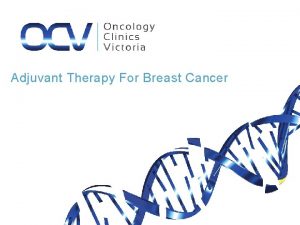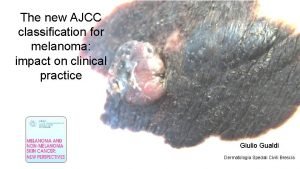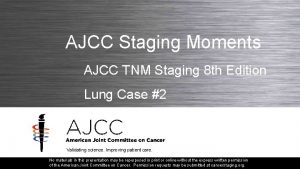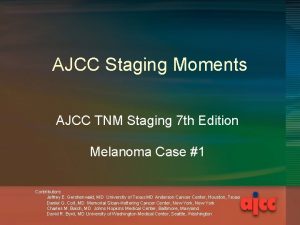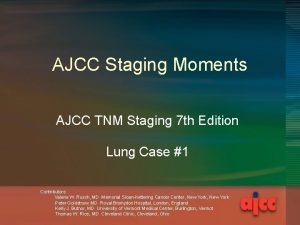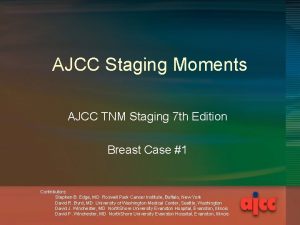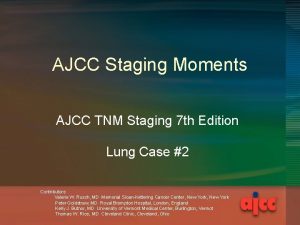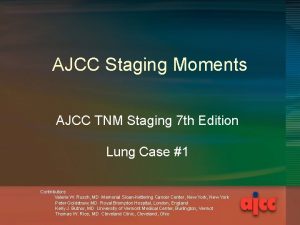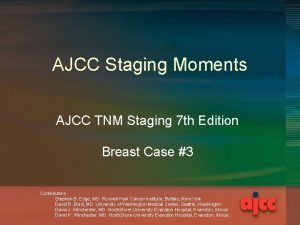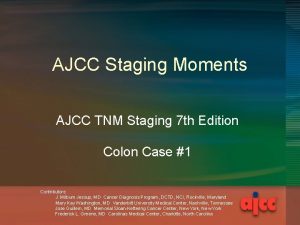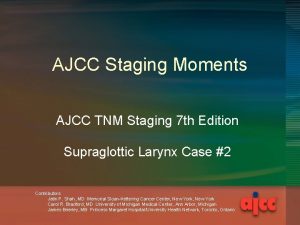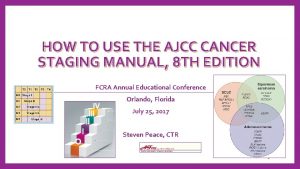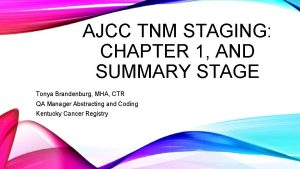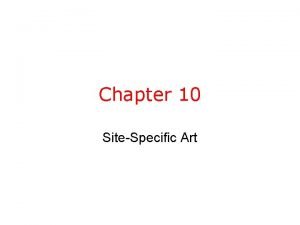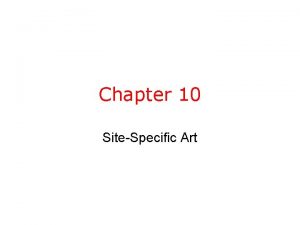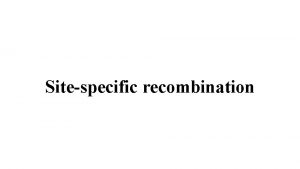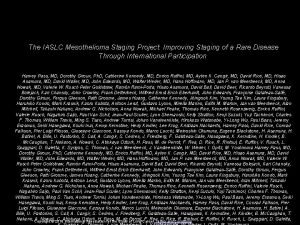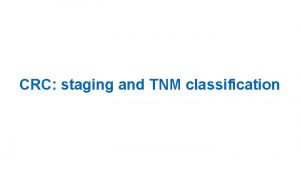NEW SITESPECIFIC FIELDS REQUIRED FOR STAGING AJCC 8


























- Slides: 26

NEW SITE-SPECIFIC FIELDS “REQUIRED FOR STAGING” AJCC 8 TH ED. FCRA Annual Educational Conference Orlando, Florida July 25, 2017 Steven Peace, CTR 1

Outline • 2018 Transition from CS SSFs to Individual Site-Specific Prognostic Factor Fields (SSFs) • Locating SSFs in the AJCC Cancer Staging Manual, 8 th edition • Historical SSFs - Still Required for Staging - Moved into New Fields • New Site Specific Fields - Shared Across Chapters – Moved into New Fields • New Site Specific Prognostic Factor Fields - Required to Assign Stage Group • Pending Site Specific Prognostic Factor Fields - Recommended for Clinical Care • Using the Site Specific Fields Required for Staging to Assign Stage Group • What if the Required SSF is missing? Can I still assign Stage Group? • QC NOTE: Analytic Cases with No Attempt to Code SSFs Increasing in Frequency • Prognostic Factors Manual & Training • Questions 2

Transition from CS SSFs to Individual Fields New Manual to Include ALL Site-Specific Fields Description of Test, Instructions and Codes ALL Previous CS SSFs in New Fields ALL NEW Required for Staging Fields - Approved New Optional Prognostic Site-Specific Fields - Not Approved - Yet TO 3

Required/Clinically Relevant/Investigational 4

Tumor Marker or Genetic Alteration Tumor Marker • Tumor Markers are indicators of cellular, biochemical, molecular or genetic alterations by which neoplasia can be recognized. • Tumor markers detect the presence of tumor based on quantitative and/or qualitative measurements in blood or secretions found in cells, tissues or body fluids. • • These surrogate measures of the biology of the cancer provide insight in the clinical behavior of the tumor. Biochemical or immunologic counterparts of differentiation states of tumor. Genetic Alteration • Cancer is a multigene disease that arises as a result of mutational and epigenetic changes coupled with activation of complex signaling intra and extra cellular networks. • Alterations in 3 Classes of Genes • Proto. Oncogenes • Tumor Suppressor Genes • DNA Repair Genes • Resultant effects on death mechanisms embedded within cells coupled with dysregulation of cell proliferation events. • Types of Mutations • Gene Rearrangement • Point Mutations • Gene Amplification 5

Comparison of the histopathology, molecular pathology, genetic, and gene-expression analysis methods used to delineate breast cancer tumor subtypes and suggested current and future therapies in a historical context http: //www. nature. com/article-assets/npg/nrclinonc/journal/v 4/n 9/images/ncponc 0908 -f 1. jpg 6

Locating SSFs in AJCC Staging Manual, 8 th ed. Chapter Specific Prognostic Factors Section in Chapter Registry Data Collection Variables Listed in Chapter 7

Site-Specific Fields Required for Staging HER 2 • Each Chapter includes the Site-Specific Fields Required for Staging (if any) • You MUST also document ALL Site-Specific Field Values/Results in TEXT s B Symptom I CEA MS • You MUST look for these tests and results – they are really important! ER/PR • Analytic Cases MUST include valid entries in these critical fields Immuno. Pheno type • Non-Analytic Cases SHOULD include valid entries as available Ki-67 Index CA 125 • FCDS will monitor overuse of 999 default values CA 199 • Include same tests as CS SSFs for some cancers • Instructions and Codes may differ from CS PSA • Field Length and Location of Decimal • Site-Specific Fields Manual Pending Gle aso • Other – age, LVI, LN +/exam, T Size n tic o t i M nt Cou Sp eci Gra fied de s Cyto. Genetic 8

Sample New SSFs - Required for Staging

Historical SSFs - Still Required for Staging Ø Ø Ø New Fields New Instructions New Codes & Definitions Improved Abstractor Notes (not displayed here) New Field Format – Alphabetical and Numerical New Field Length – Where Is Your Decimal Point? 10

New SSFs - Shared Across Chapters AJCC Grade Clinical AJCC Grade Pathologic (16) Esophagus and Esophagogastric Junction (19) Appendix – Carcinoma (38) Bone (appendicular skeleton, spine, and pelvis) (40) Soft Tissue Sarcoma of the Head and Neck (41) Soft Tissue Sarcoma of the Trunk and Extremities (42) Soft Tissue Sarcoma of the Abdomen and Thoracic Visceral Organs (44) Soft Tissue Sarcoma of the Retroperitoneum (45) Soft Tissue Sarcoma – Unusual Histologies and Sites (48) Breast AJCC GIST Mitotic Count Clinical AJCC GIST Mitotic Count Pathologic (43) Gastrointestinal Stromal Tumor AJCC Oropharyngeal p 16 Revised LVI (10) HPV-Mediated (p 16+) Oropharyngeal Cancer (11) Oropharynx (p 16−) and Hypopharynx All 11

New SSFs - Required to Assign Stage Group AJCC Testis Serum Markers Clinical AJCC Testis Serum Markers Pathologic AJCC Esophagus and EGJ Tumor Epicenter AJCC Retinoblastoma Heritable Trait (9) Testis (16) Esophagus and Esophagogastric Junction (68) Retinoblastoma Revised SSF 25 (Lip/vermillion border) C 00. 0 -upper lip, C 00. 1 -lower lip, C 00. 2 -lip NOS. Cancers of the external lip are staged using AJCC chapter 7. Cancers of the vermillion border are staged using AJCC chapter 15. Revised SSF 25 (cervical node unknown primary) Occult Head/Neck 1) patients with EBV-related cervical adenopathy are staged according to Chapter 9 (Nasopharynx); (2) patients with HPV-related cervical adenopathy are staged according to Chapter 10 (HPV-mediated oropharyngeal cancer (p 16+)); (3) all other patients with EBV-unrelated and HPV-unrelated cervical adenopathy are staged according to Chapter 6 AJCC CLL/SLL Absolute Lymphocyte Count AJCC CLL/SLL Adenopathy AJCC CLL/SLL Organomegaly AJCC CLL/SLL Anemia AJCC CLL/SLL Thrombocytopenia (79) Hodgkin and Non-Hodgkin Lymphomas AJCC MM/Plasma Cell Serum β 2 -microglobulin AJCC MM/Plasma Cell Serum albumin AJCC MM/Plasma Cell LDH Level AJCC MM/Plasma Cell FISH Results (82) Multiple Myeloma and Plasma Cell Disorders 12

New SSFs - Required to Assign Stage Group 13

New SSFs - Required to Assign Stage Group 14

The “Complete List” of Required SS Fields 15

Pending SSFs - Recommended for Clinical Care Lifestyle Factors o Tobacco Use o Depression o Alcohol Virus Exposures o P 16/HPV o HIV o Hep B or Hep C Overall Health Status o Comorbidity(s) o Overall Health o Performance Status o Zubrod/ECOG o Karnofsky Other Anatomic Info o Location of Positive Lymph Node(s) o Size of Positive Node o Extranodal Extension o Perineural Invasion o Tumor Thickness o Depth of Invasion o Surgical Margins • Clinically Relevant Site Specific Prognostic Variables are in the AJCC Staging Manual • New Site Specific Fields not yet created to store these variables • ALL are Pending Review • None are Required in 2018 • None are Optional in 2018 • No Instructions or Codes – Yet. 16

“Complete List” of Clinically Relevant SSFs 17

“Complete List” of Clinically Relevant SSFs 18

Manual to Include Complete Site-Specific Field Definitions, Instructions & Codes Do Not Use Old Manuals for New Site Specific Field Definitions, Instructions, or Codes 2018 - New Manual for ALL New Site Specific Fields – Date TBA Will Include All Required for Staging Fields May Include Some Recommended for Clinical Care Fields Definitions, Instructions, and Codes Included 19

Using Required SSFs to Assign Stage Group 20

What if the Required SSF Info is Missing? Recipe Includes Ingredients AND Instructions Cake will be fine without using baking power – right? --- I am in a hurry– Can I bake the cake @ 500 o for 15 min? No Substitutions 21

Analytic Cases with No Attempt to Code SSFs Default Value ‘ 999’ or NOS = No Value Use All Resources in Registrar Toolbox 22

Site-Specific Prognostic Factors Training 23

FCDS Prognostic Factors Webcast – 9/21/17 24

Resources Genetic Testing and Molecular Biomarkers is the leading peerreviewed journal covering all aspects of human genetic testing including molecular biomarkers. The Journal provides a forum for the development of new technology; the application of testing to decision making in an increasingly varied set of clinical situations; ethical, legal, social, and economic aspects of genetic testing; and issues concerning effective genetic counseling. This is the definitive resource for researchers, clinicians, and scientists who develop, perform, and interpret genetic tests and their results. Genetic Testing and Molecular Biomarkers coverage includes: o o o Diagnosis across the life span Risk assessment Carrier detection in individuals, couples, and populations Novel methods and new instrumentation for genetic testing Results of molecular, biochemical, and cytogenetic testing 25 Genetic counseling

Questions 26
 Ajcc staging breast
Ajcc staging breast Ajcc staging breast
Ajcc staging breast Red fields
Red fields Microsatellitosi
Microsatellitosi Sju principer för tillitsbaserad styrning
Sju principer för tillitsbaserad styrning Plats för toran ark
Plats för toran ark Nationell inriktning för artificiell intelligens
Nationell inriktning för artificiell intelligens Nyckelkompetenser för livslångt lärande
Nyckelkompetenser för livslångt lärande Ro i rom pax
Ro i rom pax Mästare lärling modell
Mästare lärling modell Matematisk modellering eksempel
Matematisk modellering eksempel Cks
Cks Adressändring ideell förening
Adressändring ideell förening Verktyg för automatisering av utbetalningar
Verktyg för automatisering av utbetalningar Shivaismen
Shivaismen Urban torhamn
Urban torhamn Slyngexcision
Slyngexcision Boverket ka
Boverket ka Strategi för svensk viltförvaltning
Strategi för svensk viltförvaltning Verksamhetsanalys exempel
Verksamhetsanalys exempel Standardavvikelse
Standardavvikelse Tack för att ni har lyssnat
Tack för att ni har lyssnat Datorkunskap för nybörjare
Datorkunskap för nybörjare Läkarutlåtande för livränta
Läkarutlåtande för livränta Treserva lathund
Treserva lathund Vad står k.r.å.k.a.n för
Vad står k.r.å.k.a.n för Inköpsprocessen steg för steg
Inköpsprocessen steg för steg
